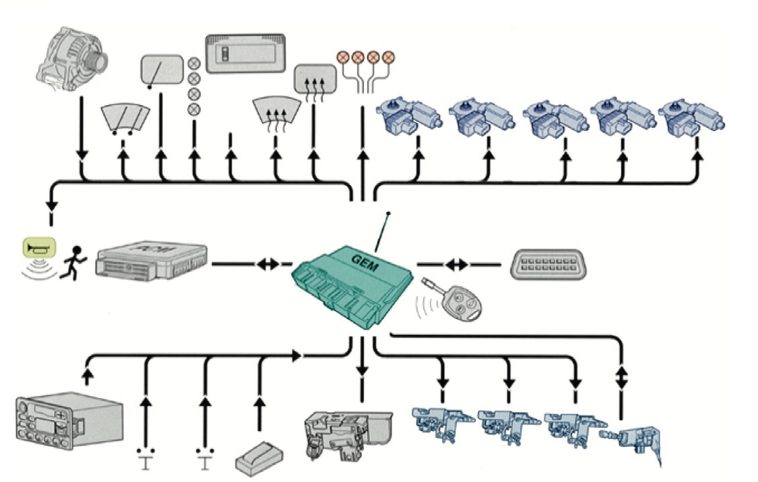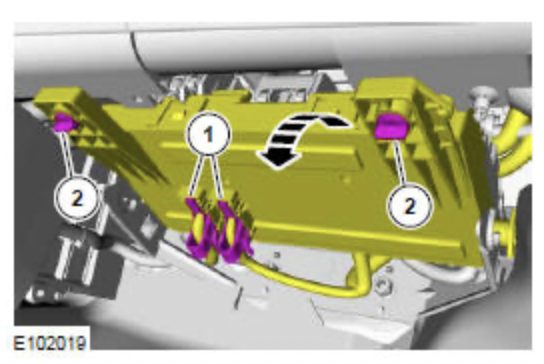General Electronic Module (GEM) is an electronic component used in modern automobiles. It is also known as a Body Control Module (BCM) or a Central Timer Module (CTM). The GEM controls various electrical systems in the vehicle, including lighting, wipers, door locks, and many more. In this blog post, we will discuss the components of the GEM and how it works.
Components of GEM: The GEM consists of various electronic components that work together to control the electrical systems in the vehicle. Here are some of the components of the GEM:
- Microprocessor: It is the brain of the GEM. The microprocessor receives signals from various sensors and switches and processes them to control the electrical systems.
- Power supply: The GEM requires a constant supply of power to function. The power supply is responsible for providing power to the GEM.
- Input sensors: The GEM receives input from various sensors in the vehicle, including the light sensor, rain sensor, and door sensor. These sensors provide information to the GEM about the status of the vehicle.
- Output devices: The GEM controls various output devices, including the headlights, taillights, interior lights, and wipers. It sends signals to these devices to turn them on or off as required.
- Memory: The GEM has a memory where it stores data about the vehicle’s electrical systems. This memory helps the GEM to remember the settings and preferences of the driver.

How does GEM work? The GEM receives input from various sensors and switches in the vehicle. The microprocessor in the GEM processes this input and sends signals to the output devices to control them. For example, when the light sensor detects that it is dark outside, it sends a signal to the GEM. The microprocessor in the GEM processes this signal and sends a signal to the headlights to turn them on.
The GEM also has the capability to communicate with other electronic components in the vehicle, including the Engine Control Module (ECM) and the Transmission Control Module (TCM). This communication helps the GEM to coordinate the electrical systems in the vehicle with the engine and transmission.
Conclusion: The General Electronic Module (GEM) is an essential component in modern automobiles. It controls various electrical systems in the vehicle and ensures that they function correctly. The GEM consists of various electronic components that work together to provide a smooth driving experience. It is essential to ensure that the GEM is functioning correctly to prevent any electrical system issues in the vehicle. If you experience any issues with the electrical systems in your vehicle, it is advisable to take it to a certified mechanic who can diagnose and repair any problems with the GEM.
The GEM is an electronic component that controls and coordinates various electrical systems in modern automobiles. It is a central hub for all the electrical systems and sensors in the vehicle, allowing them to communicate and work together seamlessly. The GEM receives input from various sensors and switches in the vehicle, processes them, and sends signals to output devices to control them.
The microprocessor is the most crucial component of the GEM. It is responsible for processing the input signals and controlling the output devices. The microprocessor is a small computer chip that can process large amounts of data at high speeds. It has a program installed on it that tells it how to process the input signals and control the output devices.
The power supply is another critical component of the GEM. It is responsible for providing a constant supply of power to the GEM. The power supply ensures that the GEM receives the required voltage and current to function correctly.

The input sensors in the GEM provide information about the vehicle’s status to the microprocessor. For example, the light sensor detects the ambient light conditions and sends a signal to the GEM. The GEM processes this signal and sends a signal to the headlights to turn them on or off.
The output devices in the GEM are responsible for controlling various electrical systems in the vehicle. These output devices include the headlights, taillights, interior lights, wipers, power windows, door locks, and many more. The GEM sends signals to these devices to turn them on or off as required.
The memory in the GEM stores data about the vehicle’s electrical systems. This memory helps the GEM to remember the settings and preferences of the driver. For example, if the driver prefers to have the headlights on during the day, the GEM will remember this setting and turn the headlights on automatically during the day.
In conclusion, the GEM is an essential component in modern automobiles. It controls and coordinates various electrical systems in the vehicle, ensuring that they function correctly. The GEM consists of various components, including the microprocessor, power supply, input sensors, output devices, and memory. It is crucial to ensure that the GEM is functioning correctly to prevent any electrical system issues in the vehicle. If you experience any issues with the electrical systems in your vehicle, it is advisable to take it to a certified mechanic who can diagnose and repair any problems with the GEM.

Advantages of General Electronic Module (GEM):
- Centralized control: The GEM is a centralized control module for various electrical systems in the vehicle. It allows for seamless communication and coordination between different systems, resulting in better overall performance and reliability.
- Efficient power management: The GEM is responsible for managing the power supply to various electrical systems in the vehicle. It ensures that power is only provided when necessary, leading to improved fuel efficiency and reduced emissions.
- Improved safety: The GEM controls various safety systems in the vehicle, such as the headlights, taillights, and brake lights. It ensures that these systems are functioning correctly, improving the overall safety of the vehicle.
- Enhanced driver experience: The GEM stores data about the vehicle’s electrical systems, such as the driver’s preferences and settings. It ensures that these settings are maintained, providing a more personalized and comfortable driving experience.
Disadvantages of General Electronic Module (GEM):
- Complexity: The GEM is a complex electronic module that requires specialized equipment and expertise to diagnose and repair. This can result in higher repair costs and longer downtime for the vehicle.
- Cost: The GEM is an expensive component, and its replacement can be costly. This can make repairs and maintenance of the electrical systems in the vehicle more expensive.
- Reliability: The GEM is a critical component of the vehicle’s electrical systems. If it fails, it can cause significant issues with the vehicle’s electrical systems, leading to reduced reliability and increased downtime.
- Limited customization: The GEM controls various electrical systems in the vehicle, and customization options may be limited. It may not be possible to modify or add new electrical systems without affecting the performance of the GEM.
In conclusion, the General Electronic Module (GEM) has many advantages, including centralized control, efficient power management, improved safety, and enhanced driver experience. However, it also has some disadvantages, such as complexity, cost, reliability, and limited customization options. Overall, the GEM is a critical component in modern automobiles, and it is essential to ensure that it is functioning correctly to prevent any issues with the vehicle’s electrical systems.








